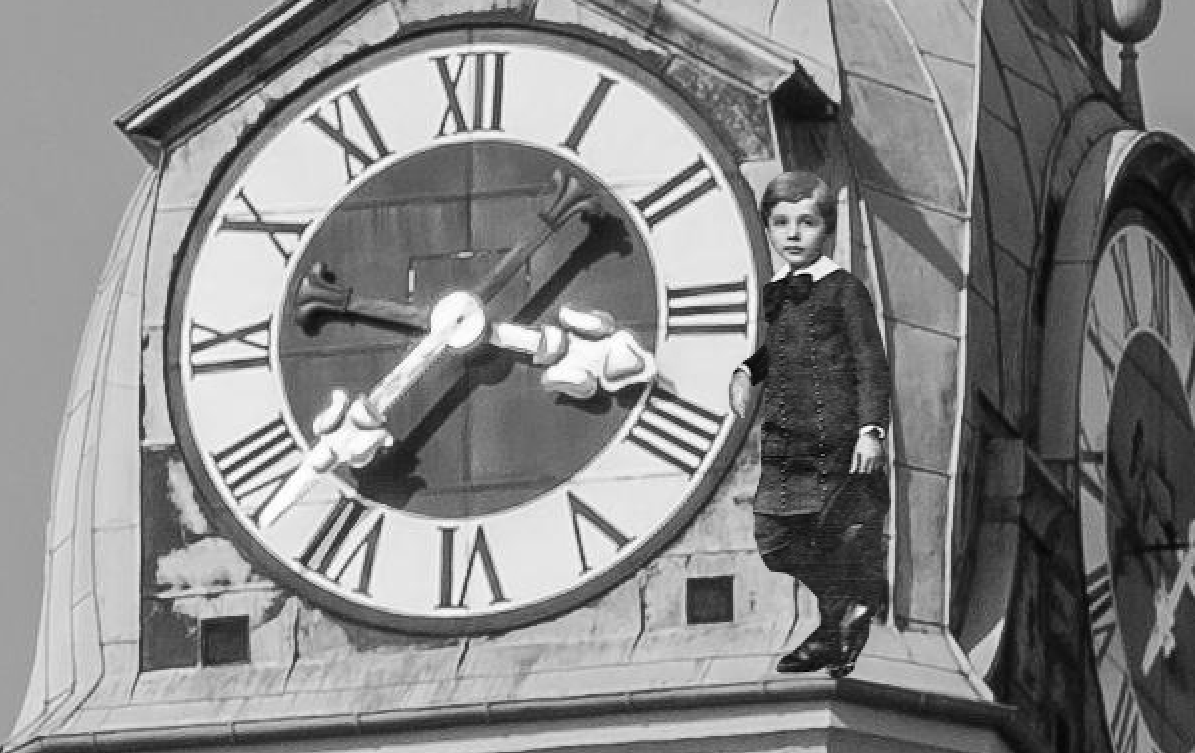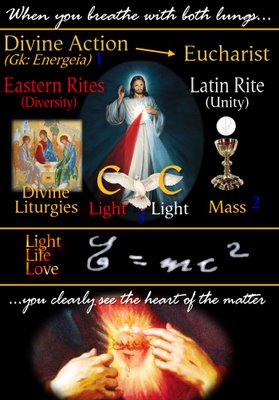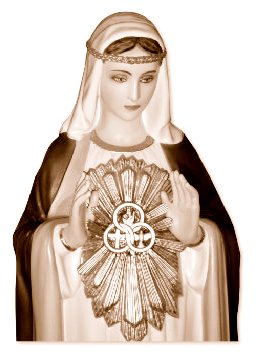Einstein at the Catholic Petersschule...Religious Paradise?
Read the following account
and tell me what is missing
from this narrative on Einstein's early life.
In contrast to Maja's report that the private tutor stimulated in Albert religious feelings, Moszkowski claimed that the beauty and splendor of nature opened the gate of the "religious paradise," as Einstein once called this phase of his youth. Moszkowski pointed out that yet another factor played an important role in Albert's religious feeling, and that was music. Ever since he took violin lessons at age six, Einstein found music intimately related with religious sentiments.
Signs of his love for music showed themselves very early. He thought out little songs in praise of God, and used to sing them to himself in the pious seclusion that he preserved even with respect to his parents. Music, Nature, and God became intermingled in him in a complex of feeling, a moral unity, the trace of which never vanished, although later the religious factor became extended to a general ethical outlook on the world. At first he clung to a faith free from all doubt, as had been infused into him by the private Jewish instruction at home and the Catholic instruction at school. He read the Bible without feeling the need of examining it critically; he accepted it as a simple moral teaching and found himself little inclined to confirm it by rational arguments as his reading extended very little beyond its circle.
That "Music, Nature, and God became intermingled in him in a complex of feeling" may well serve as a leitmotiv in this study of Einstein's religiosity. His conception of the relation between Nature and God will engage our attention throughout the discussions. The following episode illustrates how music and God were related in Einstein's mind. On April 12, 1930, the Berlin Philharmonic Orchestra, conducted by Bruno Walter, gave a concert in Berlin. The program was Bach, Beethoven, and Brahms, and the soloist was Yehudi Menuhin. At the end of the recital, the audience burst into wild applause, and Einstein rushed over to Menuhin, embraced him, and exclaimed, "Now I know there is a God in heaven!"
Because Moszkowki's book is essentially a report on conversations with Einstein, Einstein's own account of his early religiosity should fully agree with Moszkowski's report. Surprisingly, this is not the case. In his 1949 autobiographical notes, Einstein wrote:
when I was a fairly precocious young man, the nothingness of the hopes and strivings which chases most men restlessly through life came to my consciousness with considerable vitality. Moreover, I soon discovered the cruelty of that chase, which in those years was more carefully covered up by hypocrisy and glittering words than is the case today. By the mere existence of his stomach, everyone was condemned to participate in that chase. Moreover, it was possible to satisfy the stomach by such participation, but not man insofaras he is a thinking and feeling being. As the first way out, there was religion, which is implanted into every child by way of the traditional education machine. Thus I came—despite the fact that I was the son of entirely irreligious (Jewish) parents—to a deep religiosity.
According to Einstein's recollection, the root of his religiosity, as we see, was neither a love of nature nor music; it was rather his realization of the vanity of human rivalry in the struggle for existence with its concomitant feeling of depression and desperation from which religion seemed to offer a relief. Such an attitude toward life can hardly have been entertained by a young boy, however. It seems, therefore, that Einstein's account is rather a projection of ideas pertaining to his mature age into his youth.
Historical surveys of Munich's educational system and other sources provide some information about the curriculum of Einstein's religious instruction at the Petersschule as well as at the Luitpold Gymnasium, the secondary school in which he enrolled in the beginning of 1888. At the Catholic primary school, he was taught, at age seven, parts of the Small Catechism (Catechismus Romanus) and biblical tales of the New Testament; at age eight, sections of the Large Catechism and biblical stories of the Old Testament; and at age nine years, other parts of the Old Testament and the sacraments, baptism, and the Lord's Supper.
As the only Jew in his class, Albert seemed never to have felt uncomfortable—with the possible exception of one incident. In one of these lessons, the teacher, a Catholic priest, held up a big nail and reportedly said that "these were the nails with which Christ was crucified by the Jews." According to the biographers, Rudolf Kayser and Carl Seelig, whose report is based mainly on correspondence with Einstein, the teacher intended to stir up hatred against the Jews, and all eyes in the class turned to Albert who felt very embarrassed? "For the first time Albert experienced the frightful venom of anti-Semitism," wrote Kayser (Reiser).
A somewhat different account of this episode can be found in Philipp Frank's biography of Einstein. According to Frank, the teacher said only, "The nails with which Christ was nailed to the cross looked like this," pointing to the nail he had brought. And Frank explicitly continued:
But he did not add, as sometimes happens, that the Crucifixion was the work of the Jews. Nor did the idea enter the minds of the students that because of this they must change their relations with their classmate Albert. Nevertheless Einstein found this kind of teaching rather uncongenial, but only because it recalled the brutal act connected with it and because he sensed correctly that the vivid portrayal of brutality does not usually intensify any sentiments of antagonism to it but rather awakens latent sadistic tendencies.
Frank's biography is known to be based largely on epistolary correspondence, whereas Kayser's account is based on personal conversations with Einstein. In his brief preface to Kayser's biography, Einstein declared, "I found the facts of the book duly accurate, and its characterization, throughout, as good as might be expected of one who is perforce himself, and who can no more be another than I can." It is, of course, difficult today to find out which of the two versions is true. It is also difficult to assess how such an anti-Semitic incident, had it really happened, would have affected Albert's religious attitude toward Judaism.
In any case, Albert seemed to have liked these courses and on some occasions even helped his Catholic classmates when they failed to find the correct answer. Nor did he seem to have sensed any difference between what he learned about the Catholic religion at school and about the Jewish religion at home. He learned to respect sincere religious convictions of whatever denomination, an attitude he did not abandon in his later life when he rejected any affiliation with an institutional religious organization.
This attitude is evidenced in his replies to some questions raised by George Sylvester Viereck during a 1929 interview.
"To what extent are you influenced by Christianity?"
"As a child I received instruction both in the Bible and in the Talmud. I am a Jew, but I am enthralled by the luminous figure of the Nazarene."
"Have you read Emil Ludwig's book on Jesus?"
"Emil Ludwig's Jesus is shallow. Jesus is too colossal for the pen of phrasemongers, however artful. No man can dispose of Christianity with a bon mot!"
"You accept the historical existence of Jesus?"
"Unquestionably! No one can read the Gospels without feeling the actual presence of Jesus. His personality pulsates in every word. No myth is filled with such life."
The arrangement of religious instruction at the Luitpold Gymnasium differed from that at the Catholic Volksschule in several respects. As an interdenominational school, the Gymnasium offered special courses of religious instruction to its Jewish pupils. In contrast to the three weekly hours at the Petersschule, only two hours per week were devoted to religious studies, and these were given by external teachers especially ordained for this purpose by the Jewish community of the city. Einstein's first teacher was Herr Heinrich Friedmann. In his classes, which were shared by Einstein's Jewish classmates and the Jewish pupils of his next higher grade, Friedmann taught the Ten Commandments, biblical history, selected chapters of the Old Testament, the rituals of the Jewish holy days, and the rudiments of Hebrew grammar.
From 1892 to 1895, the year Albert left Munich to join his parents in Italy without having completed his schooling, his teachers of religion were Dr. Joseph Perles, Eugene Meyer, and Dr. Cossmann Werner. They introduced him to the literature of the Psalms, and the history of the Talmud and of the Jews in Spain. Unfortunately, because these external teachers did not enjoy the same authority as their full-time colleagues at the Gymnasium, the attitude of their pupils toward their lessons seems to have been less serious that it should have been. Einstein referred to this in 1929 when he received fiftieth-birthday congratulations from his old teacher Heinrich Friedmann. Einstein declared: "I was deeply moved and delighted by your congratulations. How vividly do I remember those days of my youth in Munich and how deeply do I regret not having been more diligent in studying the language and literature of our fathers. I read the Bible quite often, but the original text remains inaccessible for me. It certainly was not your fault; you have fought valiantly and energetically against laziness and all kinds of naughtiness."
Einstein could have added that neither had it been Friedmann's fault nor the fault of any other of his teachers of religion that, at the age of twelve, just when he should have been preparing for the bar mitzvah, the Jewish confirmation, he suddenly became completely irreligious. Ironically, this conversion was, indirectly at least, the consequence of the only religious custom that his parents observed, namely to host a poor Jewish student for a weekly meal. The beneficiary was Max Talmud, a medical student from Poland, ten years older than Albert. In spite of their age difference, Albert and Talmud became intimate friends, and this friendship changed Albert's attitude toward religion. Because Talmud (or Talmey, as he called himself later when working as a general practitioner in New York) wrote a book on relativity in which he described his visits to the Einsteins in Munich, we have an authentic account of the influence he exerted on Albert. He directed Albert's attention to Aaron Bernstein's popular Naturwissenschaftliche Volksbücher (Popular Books on Physical Science), Ludwig Büchner's materialistic Kraft und Stoff (Force and Matter), Immanuel Kant's Kritik der Reinen Vernunft
(Critique of Pure Reason) as well as to various books on geometry and other branches of mathematics. Einstein himself summed up the results of Talmey's influence:
Through the reading of popular scientific books I soon reached the conviction that much in the stories of the Bible could not be true. The consequence was a positively fanatic [orgy of] freethinking coupled with the impression that youth is intentionally being deceived by the state through lies; it was a crushing impression. Suspicion against every kind of authority grew out of this experience, a skeptical attitude towards the convictions which were alive in any specific social environment—an attitude which has never again left me, even though later on, because of a better insight into the causal connections, it lost some of its original poignancy.
An immediate consequence of this change of mind was the fact that Einstein refused to become bar mitzvahed. Although this ceremonious act, introduced in the thirteenth century, is not a "halachist" (necessary) condition for membership in the Jewish community, even liberal Jews regard it as a precept that must be obeyed. By not complying with it, Einstein obviously intended to demonstrate his personal independence from the dictates of traditional authority. The nonperformance of his bar mitzvah would have caused serious political problems, at least on the part of the orthodoxy, had Einstein accepted David Ben-Gurion's offer in November 1952 to become the second president of the State of Israel after the death of Chaim Weizmann.
Interestingly, when he was living in Berlin, Einstein did own a pair of phylacteries (tephillin). Needless to say, Einstein never performed the ritual of putting them on as religious Jews used to do after becoming bar mitzvah. He kept them obviously only as an heirloom or memento of his ancestors. In May 1933, four months after Einstein had left Germany, his apartment on Haberlandstrasse 5 was raided by the Gestapo under the pretext of searching for anti-German propaganda literature, and these phylacteries and a prayer book, together with valuable pictures and cutlery, were looted.
Einstein's indifference concerning religious affiliations is also shown by the fact that his first wife Mileva Maric, a fellow student at the Polytechnic in Zurich, belonged to the Greek Orthodox Church. Their marriage took place in Zurich in 1903 and was a civil ceremony without the presence of a rabbi or a priest. Both sets of parents had strongly opposed the marriage, mostly because of the difference in their religious backgrounds. After their two sons, Hans Albert and Eduard, were born, questions arose regarding their religious instruction and therefore their elementary school education. Einstein reportedly said, `Anyway, I dislike very much that my children should be taught something that is contrary to all scientific thinking."
As far as we know, Einstein never attended religious service and never prayed in a synagogue or at any other place of worship. He visited such places only to participate in social events. The following examples illustrate this fact. On January 29, 1930, he participated at a Welfare Concert for the benefit of the Youth Department of the Jewish Community, which took place in Berlin's "Neue Synagoge" located at 30 Oranienburger Strasse. The program included arias sung by the famous tenor Hermann Jadlowker and the Adagio in B-minor for two violins by Johann Sebastian Bach, played by Einstein and the violist Alfred Lewandowski. Early in March 1933, at the end of his second visit to the United States, Einstein became the godfather of Albert, the eight-day-old son of Jacob Landau, the director of the Jewish Telegraphic Agency, at a ceremony in a New York synagogue. During the last two decades of his life, Einstein participated once every two or three years at the discussions that concluded the Friday evening service for Jewish students at Princeton University.
Einstein's last wish was not to be buried in the Jewish tradition, but to be cremated and his ashes scattered, indicating that he disregarded religious rituals until his death on 18 April 1955.
and the Role of Religion in His Private Life
Here are five pressing questions:
1. Is it logical to assume that a young Albert Einstein was required
to at least sit in the Church pew when his school attended Holy Mass?
2. What religious order taught at the Petersschule?
3. Was there a chapel on the campus and did the children
go there at any time during the school day?
4. Did the faculty ever take the school children
on a trip to the glorious churches in the near vicinity
of Munich's historic Sendlinger Tor?
St. Peter's Church, Munich
5. Did young Albert ever have to take a religion test
and answer catechism questions
with the truth about God and Jesus and Mary?
Marienplatz, Munich
Thus saith Albert concerning Mileva and Hans' conversion:
"They've turned Catholic.
Well, it's all the same to me"
My hunch is that Albert gazed at this clock tower, high atop St. Peter's
and it had a lasting effect....one that was fulfilled when he gazed
at the tower in Bern, Switzerland seventeen years later.
Sincerely yours in Jesus through Mary,
Mike Rizzio
Imitate Mary
Become like Jesus
Live for the Triune God
Seek the Light of Our Lord Jesus Christ
See you on the High Ground!
* - J.M.J. + O.B.T. + M.G.R. stands for:
Jesus, Mary and Joseph;
O Beata Trinitas;
St. Michael, St. Gabriel and St. Raphael



































No comments:
Post a Comment